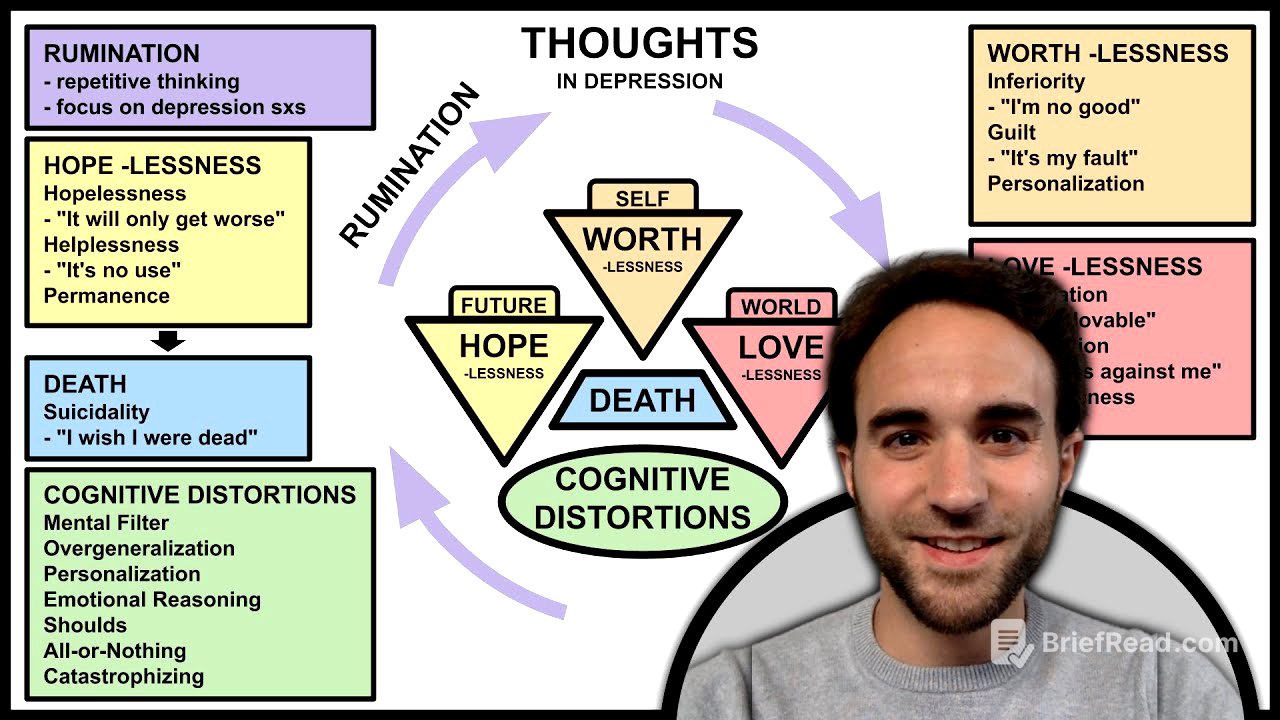TLDR;
This video provides an overview of the cognitive symptoms of depression, focusing on the negative thought patterns commonly experienced by individuals with depression. It categorizes these thoughts into worthlessness, hopelessness, and lovelessness, explaining how these relate to negative perceptions of self, future, and the world. The video also touches on the connection between hopelessness and suicidality, cognitive distortions, and the role of rumination in maintaining depressive thoughts.
- Three major categories of negative thoughts in depression: worthlessness, hopelessness, and lovelessness.
- Hopelessness is strongly linked to suicidality.
- Rumination maintains depressive thoughts.
Introduction to Cognitive Symptoms of Depression [0:00]
The video introduces the cognitive symptoms of depression, defining depression as a syndrome involving feelings, thoughts, and behaviors. The talk focuses on the thoughts and thinking patterns that commonly arise in people with depression, synthesizing data from depression screening tools, diagnostic manuals, psychodynamic therapy, and depression experts.
The Triad of Negative Thoughts: Worthlessness, Hopelessness, and Lovelessness [0:32]
The core negative beliefs in depression are categorized into three major types: thoughts of worthlessness, hopelessness, and lovelessness (or unlovability). These thoughts relate to the self, the future, and the world, forming what Beck described as the negative cognitive triad in depression.
Worthlessness: Thoughts of Inferiority and Guilt [1:07]
Worthlessness involves thoughts of inferiority, such as feeling no good or incapable, and thoughts of guilt, where individuals believe everything is their fault. Guilt is presented as an example of personalization, which is attributing negative outcomes to one's own actions without sufficient evidence.
Hopelessness: Thoughts of Permanence and Helplessness [1:32]
Hopelessness includes thoughts that things will only worsen or never improve, along with feelings of helplessness, where individuals believe nothing they do matters. The concept of permanence is highlighted, referring to the belief that negative situations are unchangeable and will last forever.
Lovelessness: Thoughts of Self-Devaluation and Persecution [1:52]
Lovelessness encompasses thoughts of self-devaluation, such as feeling unlikable or unlovable, and thoughts of persecution, where individuals feel the world is against them. These thoughts involve the concept of pervasiveness, which is the belief that negative events affect all areas of life, not just the specific context in which they occurred.
The Three P's of Pessimism and Thoughts of Death/Suicide [2:18]
Personalization, permanence, and pervasiveness form the "three P's of pessimism," as outlined by Seligman and colleagues. Thoughts of death or suicide may arise from extreme hopelessness, often linked to the belief that suffering will never end or that one is trapped in an unalterable situation.
Cognitive Distortions [2:59]
Various cognitive distortions, which are inaccurate and unhelpful ways of thinking, may arise in depression. These distortions are sometimes referred to as "thinking traps."
Rumination [3:22]
Rumination, defined as cyclical, repetitive thinking that dwells on negative thoughts, feelings, and experiences without making progress, maintains depressive thoughts. Rumination keeps depressed individuals focused on their symptoms, often amplifying them, and can be visualized as a whirlpool drawing someone deeper into negative thoughts and cognitive distortions.
Summary of Major Points [3:51]
The three major categories of negative thoughts in depression are worthlessness, hopelessness, and lovelessness. Worthlessness relates to negative thoughts about the self and personalization; hopelessness relates to negative thoughts about the future and permanence; and lovelessness relates to negative thoughts about the world and pervasiveness. Thoughts of hopelessness are strongly linked to suicidality, and rumination maintains depressive thoughts.

![[GOOVER] User's Guide 3. Let's Go Over](https://wm-img.halpindev.com/p-briefread_c-10_b-10/urlb/aHR0cDovL2ltZy55b3V0dWJlLmNvbS92aS9YTFBnZ0ZRc2hOZy9ocWRlZmF1bHQuanBn.jpg)







